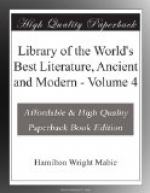The ‘Chartreuse de Parme,’ although written the same year as the ’Rouge et Noir’, was not published until 1839, two years before his death, and was judged his best effort. “He has written ‘The Modern Prince,’” declared Balzac, “the book which Macchiavelli would have written if he had been living exiled from Italy in the nineteenth century.” The action takes place at Parma; and as a picture of court life in a small Italian principality, with all its jealousies and intrigues, the book is certainly a masterpiece. But it is marred by the extravagance of its plot. The hero, Fabrice, is the younger son of a proud and bigoted Milanese nobleman, the Marquis del Dongo, who “joined a sordid avarice to a host of other fine qualities,” and in his devotion to the House of Austria was implacable towards Napoleon. Fabrice, however, was “a young man susceptible of enthusiasm,” and on learning of Napoleon’s return from Elba, hastened secretly to join him, and participated in the battle of Waterloo. This escapade is denounced by his father to the Austrian police, and on his return Fabrice is forced to take refuge in Swiss territory. About this time his aunt Gina, the beautiful Countess Pietranera, goes to live at Parma; and to conceal a love affair with the prime minister Mosca marries the old Duke of Sanseverina-Taxis, who obligingly leaves on his wedding-day for a distant embassy. Gina has always felt a strong interest for Fabrice, which later ripens into a passion. It is agreed that Fabrice shall study for the priesthood, and that Count Mosca will use his influence to have him made Archbishop of Parma, an office frequently held in the past by Del Dongos. Unfortunately Fabrice is drawn into a quarrel with a certain Giletti, a low comedy actor, whom he kills in self-defense. Ordinarily the killing of a fellow of Giletti’s stamp by a Del Dongo would have been considered a trifling matter; but this offense assumes importance through the efforts of a certain political faction to discredit the minister through his protege. The situation is further complicated by the Prince, Ernest IV., who has come under the spell of Gina’s beauty, and furious at finding her obdurate, is glad of an opportunity to humiliate her. Fabrice is condemned to ten years’ imprisonment in the Farnese tower, the Prince treacherously disregarding his promise of pardon. From this point the plot becomes fantastic. From his window in the tower, Fabrice overlooks that of Clelia, daughter of General Fabio Conti, governor of the prison. It is a case of mutual love at first sight, and for months the two hold communication by signs above the heads of the passing sentries. After his fabulous escape, effected by the help of his aunt, Fabrice is inconsolable, and at length returns voluntarily to the tower in order to be near Clelia. It is not until after the death of the Prince that the Duchess obtains Fabrice’s pardon from his son and successor. At last Clelia dies, and Fabrice enters the neighboring monastery, the Chartreuse of Parma.




